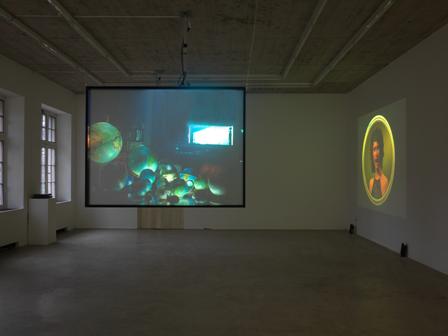BEYOND STEREOTYPES
SADIE BENNING, KEN FEINGOLD, MASHA GODOVANNAYA, DORIT MARGREITER, ASTRID NIPPOLDT, MARIANA VASSILEVA, MAGDALENA VON RUDY, PAUL WIERSBINSKI
OPENING:
Saturday 8 March 2008
8 PM
OPEN:
9 March
—
27 April 2008
In the group exhibition Beyond stereotypes the NAK presents positions of contemporary video art which circle around the play with our schematized conceptions. While the term proved as an important category of scientific argument in the film science, the role of cliché, conventional pictures and reduced narration patterns and/or conception worlds in the representation repertoire was so far little broached the issue of video art. Straight in video art a particularly various and course-sharpened form of the discourse of stereotypes can be observed. In contrast to the cinematic stereotype, which serves above all to make form and content accessible for a broad recipient layer, one finds both forms of the radical criticism and refusal as well as individual appropriation or desireful overemphasis in video art. However, the stereotyp always serves as seal, in order to pull the viewer over by produced expectations into a perception play crosswise over all reflection levels.
On the basis of Ken Feingold’s work “Un chien delicieux” the question of ones tendency of being manipulated by his own internal expectation is placed. The video shows an old Burmese, remembering the circles of the Surrealists in Paris, which he had met through the Anthropologist Michel Leiris. During his narration reality and fiction start to blur and our used cultural perspective tilt us into the strange reality of the Burmese.
Also Astrid Nippoldt’s video loop “wy o ming” plays with our standardized conceptions of the world. She develops a highly dramatic 90 seconds western, which develops exclusively from the already existing pictures in the head of the viewer.
Dorit Margreiter’s film installation “10104 Angelo View drive” is occupied with pictures which are coined by the film industry. On the basis of the late modern house of the architect John Lautner, which was introduced in numerous film productions as stereotype of the built Hollywood-Lifestyle, it examines the conventions of cinematic representation and employs surprising considerations for the social determination of architecture. The work “the milkmaid” of Mariana Vassileva refers to the same named painting by Jan Vermeer (1658), which became a firm component of the collective picture memory by numerous illustrations. Mariana Vassileva transforms the motive into a virtual space and timelessness, and at the same time produces a notion of total presence.
The young Polish artist Magdalena von Rudy connects in her work “Medusa” the painting of Caravaggio with key scenes from David Lynchs “Blue velvet” and the role of Jack Nicholson in “A question of honour”. From this cross-setting results an intensive show of sexual power roles and sexual identity construction.
The first video work of the internationally successful film director Sadie Benning titled “Girl power” concerns the difficulties of identity search of a young girl, between riot grrl, puberty and the desire for security.
At first sight the work “Untitled No. 1″of the Russian artist Masha Godovannaya seems similar. But the harsh, seductive dance of a young girl on open road however affects above all various romantic cliché, which are often connected with the life-style of the Sinti and Roma. Which reality content these conceptions have is usually also a question of ones own attitude.
Paul Wiersbinski’s work “Mystic Powers Help the World Reveal the True Artist” finally is an ironical persiflage showing young Germans in four improvised scenes as Adolf Hitler. In the intended superficialness of the representation the handling of German history and its stereotyped view is brought up for discussion.

